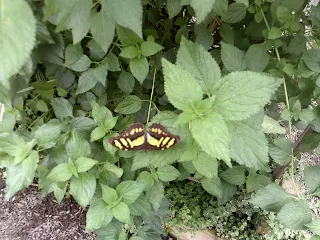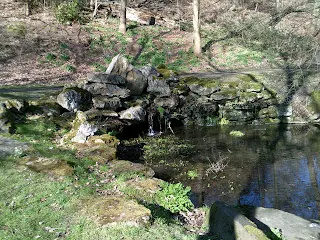The Horniman Museum is situated in south London and I've been before. This great place has been named as one of the coolest top ten museums in the world by the New York Times, and I can see why. I thought the SuperDean would quite enjoy it and I wasn't wrong. We decided to visit on a rainy day, which wasn't too much of a problem as most of what we wanted to see was indoors.
History recap:- The museum was founded in 1901 by Frederick John Horniman, a tea merchant who inherited his father's successful business. The cash generated by his livelihood allowed him to travel extensively and develop his passion for collecting musical instruments, cultural artefacts and anthropological items. He obtained some 30,000 pieces, including a massive collection of stuffed animals. The museum was designed by Charles Harrison Townsend in the Arts and Crafts style and is free, with a couple of paying, optional, add-on exhibitions. There was plenty to see, including the recently refurbished World Gallery.
History recap:- The museum was founded in 1901 by Frederick John Horniman, a tea merchant who inherited his father's successful business. The cash generated by his livelihood allowed him to travel extensively and develop his passion for collecting musical instruments, cultural artefacts and anthropological items. He obtained some 30,000 pieces, including a massive collection of stuffed animals. The museum was designed by Charles Harrison Townsend in the Arts and Crafts style and is free, with a couple of paying, optional, add-on exhibitions. There was plenty to see, including the recently refurbished World Gallery.
This is not going to be a massive blog (mind you, I've said that before, and usually end up uploading w-a-a-a-ay too many photos) for two reasons...
I've blogged about it before, after my visit last summer, and here is the link:-
My photos did not come out that great. Some of this was due to the fact that a flash wasn't allowed, although flash photography rebounding from glass cabinets can sometimes cause problems. But I also seemed to have a bit of a shaky hand that day. One thing I will do is look into getting a better camera, with a manually adjustable lens and shutter speed variations.
The Studio is a new arts space and contained an exhibition called The Lore of the Land. Artist Serena Korda worked with a Collective of local community members to create a multi-sensory, immersive installation. This exhibition includes the Horniman's anthropology collection. The items have been selected for the messages they carry about people's relationships with plants and water; both in a cultural and spiritual way.
The sculptures breathe different scents into the space and indeed, the gallery smelt pleasant! 😊 They are (to quote the museum) a 'primordial soup of encrusted barnacles, sea urchins and burgeoning fruits suggestive of a garden of earthy delights- or the kids' cult TV show, Fraggle Rock'.
I absolutely LOVED these artworks...
They are a bit sinister and reminded me of bulging eyeballs and trolls' homes!
They offered up quite a pleasant perfume, which certainly made the olfactory senses smile. I thought this one very phallic (I would!)
There is also the vibrant beat of apt music pumping through the gallery. Here is another phallus...😉
This was my favourite piece, but this is a naughty PDF as my photo was totally blurry...
The sculptures are entitled Sensitive Chaos and take their title from the work of anthropologist Theodor Schwenk He studied the spiritual relationship between all physical things.
Here's a cabinet of pipes...
Little Miss Macabre especially loved this skull pipe...
These looked quite terrifying, and reminded me of scare devils (amulets placed outside homes to ward off evil.)
Brick Wonders is a pretty good Lego exhibition and was in the gallery just opposite. It consisted of Lego reproductions of sites such as Hoover Dam (I've seen it from a plane), the Grand Canyon (ditto) and Niagara Falls (ditto again). The glare from the cabinets really interfered with my photos, so I'm just posting my favourite picture, which shows this colourful interpretation of the Great Barrier Reef.
The World Gallery was being refurbished the last time I was here. This is taken from the balcony gallery, looking down onto it...
From up here, it certainly looks quite wacky, with this crazy car...
...And mad ceiling hanging...
Downstairs, all the continents are represented. Here is a selection of curios from Asia...
Oceania. The bags are woven from recycled plastic waste...
Europe. This is called a Presepe and is an Italian representation of the birth of Jesus...
America. This is a sealskin Eskimo's suit...
Africa. Goods found in a Lagos market...
This little sign is perfection itself and was found in the above cabinet...
I'm kicking myself for not checking out the details of this lobster party setting. I told you this place was wacky!
We moved on to the aquarium and Dean questioned whether these jellyfish were real or a 3 dimensional transposition. I'm guessing the former!
Leopard-print stingray...
A real frog (this one's a poison dart and I apologise for the blurriness...)
...And a wooden frog. He was in the Music Gallery, and I don't know whether you're supposed to hit him with the stick provided, or stroke him, to get a reverberation...😆
Outside it was raining and the only animals I didn't see before were these alpacas. They were cute and came to pose- minutes after urinating. I didn't manage to catch that on camera!
We ventured into the Butterfly House and here is the pictorial guide, with a Blue Morpho resplendent on it...
Dean absolutely loved it in here, and the attraction appeared to be mutual. One of the little friends landed on him- that never happened to me!
It really is a lovely experience, for all ages to enjoy.
Feeding time...
We finished with a look around the Natural History gallery. Here is a wild cat, which Dean described as, 'Bagpuss's dirty cousin...'
I have to say, that made me laugh out loud! So I'll leave you with a picture of my Bagpuss. He sits on top of my wardrobe...
TTFN
The Miss Elaineous
XXXXXXXXXXXXXXXXXXXXXXXXX























































































